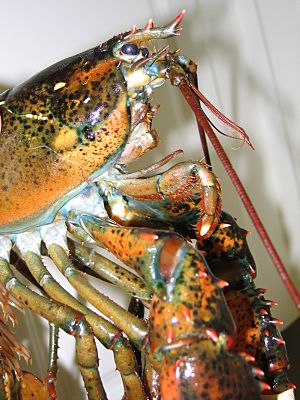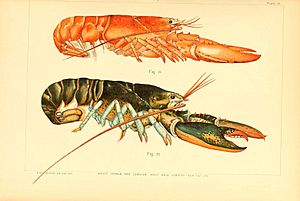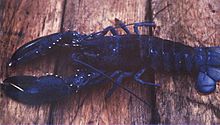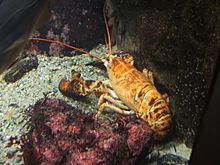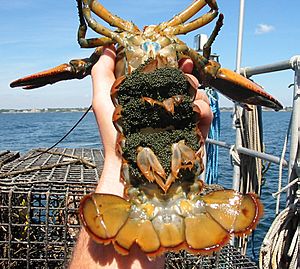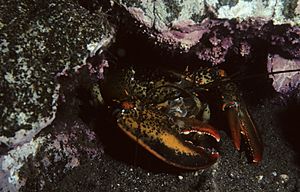American lobster facts for kids
Quick facts for kids American lobster |
|
|---|---|
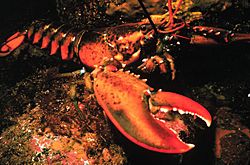 |
|
| Scientific classification | |
| Kingdom: | |
| Phylum: | |
| Subphylum: | |
| Class: | |
| Order: | |
| Infraorder: |
Astacidea
|
| Family: | |
| Genus: | |
| Species: |
H. americanus
|
| Binomial name | |
| Homarus americanus H. Milne-Edwards, 1837
|
|
The American lobster (scientific name: Homarus americanus) is a type of lobster that lives in the Atlantic Ocean. You can find them mostly along the coast of North America, from Labrador in Canada down to New Jersey in the USA. People also call them Atlantic lobsters, Canadian lobsters, or Maine lobsters.
These amazing creatures can grow up to 64 cm (25 in) long and weigh more than 20 kilograms (44 lb)! This makes them the heaviest crustacean and even the heaviest arthropod (like insects and spiders) in the world. They are usually bluish-green to brown with red spots, but some have very rare and unique colors. They are related to the European lobster, but you can tell them apart by their different colors.
Contents
Where American Lobsters Live
American lobsters, known scientifically as Homarus americanus, live along the Atlantic coast of North America. Their home stretches from Labrador in Canada all the way south to Cape Hatteras, North Carolina in the USA.
They are not very common south of New Jersey. In states like Delaware, Maryland, Virginia, and North Carolina, very few are caught. Scientists even found an ancient lobster claw from the Ice Age near Nantucket, Massachusetts. In 2013, one American lobster was even found far away near the Farallon Islands off the coast of California.
What American Lobsters Look Like
American lobsters usually grow to be 8–24 inches (200–610 mm) long and weigh 1–9 pounds (0.45–4.08 kg). But some have been found weighing as much as 44 lb (20 kg)! This makes them the heaviest crustacean in the world. They are also the longest decapod crustacean. An average adult is about 9 in (230 mm) long and weighs 1.5 to 2 lb (680 to 910 g).
The longest American lobsters have bodies (not counting their claws) that are 64 cm (25 in) long. The heaviest one ever found was off Nova Scotia, Canada. It weighed an incredible 44.4 lb (20.1 kg)!
Their first pair of legs, called pereiopods, have two big, different-sized claws. The larger one is called the "crusher." It has rounded bumps and is used to crush their food. The other claw is the "cutter." It has sharp edges and is used for holding or tearing food apart.
American lobsters love cold, shallow waters. They like places with many rocks and spots to hide from animals that might try to eat them. They usually live about 4–50 m (13–164 ft) deep. But they can be found as deep as 480 m (1,570 ft) below the surface.
Their antennae are about 2 in (51 mm) long and split into Y-shapes. These tips have many tiny hairs with nerve cells that can smell things. Larger hairs around the edges help push water with smells towards the smaller sensory hairs.
They also have shorter antennules, which help them smell even more. Having two smelling organs helps a lobster figure out where a smell is coming from, just like how humans use two ears to know where a sound is coming from. Besides smelling, their antennae can also tell how fast the water is moving, which helps them find their way.
Lobsters have two urinary bladders, one on each side of their head. Lobsters use smells in their urine to communicate with each other. They can spray long streams of urine 1–2 meters (3 ft 3 in – 6 ft 7 in) in front of them. They do this when they find a rival lobster or a possible mate nearby.
Lobster Colors
Most American lobsters are "dark bluish-green to greenish-brown." Their bodies and claws are redder, and their legs are greener. This color comes from a mix of yellow, blue, and red colors in their bodies. Even though they are rare, many strangely colored lobsters are caught.
- Blue Lobsters: About 1 in 2 million lobsters are blue. A special change in their genes makes a blue lobster produce too much of a certain protein.
- Yellow Lobsters: These are even rarer, about 1 in 30 million. They also have a rare genetic change.
- Albino Lobsters: In July 2010, an albino lobster was caught in Gloucester, Massachusetts. These lobsters have no color at all. Only about 1 in 100 million lobsters are albino.
- Red Lobsters: Most red lobsters are red because they have been cooked. But there is a 1 in 10 million chance of catching a live red lobster!
How Lobsters Grow
Lobsters usually mate right after the female has molted (shed her old shell). At this time, her new shell is still soft. The female releases a special scent called a pheromone. This scent makes the males less aggressive and starts their courtship dance, where they keep their claws closed.
The female then releases her eggs. These eggs stick to her pleopods (small legs under her tail) with a sticky substance. She takes care of them there until they are ready to hatch. She cleans the eggs often and fans them with water to give them oxygen. This takes about 10 to 11 months.
Inside the egg, the baby lobster goes through several molts before it hatches as a tiny larva called a metanauplius. When the eggs hatch, the female waves her tail in the water. This releases batches of these tiny larvae into the ocean.
The metanauplius larva is only about 1⁄3 in (8.5 mm) long. It is clear, has big eyes, and a long spine on its head. It quickly molts again. The next three stages are similar but larger. These molts take 10 to 20 days. Only about 1 in 1,000 larvae are thought to survive to become young lobsters.
To reach the fourth stage, the larva changes a lot, a process called metamorphosis. It starts to look much more like an adult lobster. It is about 1⁄2 in (13 mm) long and swims using its pleopods. At this stage, its claws are still small. So, if it feels threatened, it mostly escapes by flipping its tail.
After its next molt, the lobster sinks to the ocean floor. It then starts living on the bottom, which is called a benthic lifestyle. It molts less and less often. At first, it might molt ten times a year. Later, it only molts once every few years.
After one year, a young lobster is about 1–1.5 in (25–38 mm) long. After six years, it might weigh 1 pound (0.45 kg). By the time it is big enough to be caught, a lobster may have molted 25 to 27 times. Each molt after that can make it 40% to 50% heavier! If adult lobsters are in danger, they usually choose to fight, unless they have lost their claws.
What Lobsters Eat
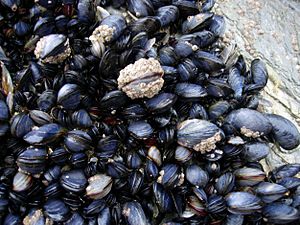
The American lobster, H. americanus, eats pretty much the same things no matter where it lives. Their main foods are mollusks (like mussels), echinoderms (like sea stars), and polychaetes (a type of worm).
However, they can eat many other things too. This includes other crustaceans, brittle stars, and even cnidarians (like jellyfish). Lobsters in Maine have been shown to get a lot of their energy (35-55%) from herring. Herring is often used as bait in lobster traps. Interestingly, only about 6% of lobsters that go into traps to eat the bait actually get caught.
Lobsters as Food
American lobsters are a very popular food. People usually cook them by boiling or steaming them. Lobsters with hard shells (meaning they molted several months ago) can live out of water for up to four or five days if they are kept cold. Lobsters with soft shells (meaning they just molted) do not live more than a few hours out of water.
Lobsters are usually cooked alive. Some people think this is not kind to the animal, and it is even against the law in some places. A common way to serve lobster is with beef, a meal called surf and turf.
Lobsters have a greenish or brownish organ called the tomalley. This organ works like a liver and pancreas in humans. It helps filter out toxins from the lobster's body. Some people think the tomalley is a tasty treat, but others avoid it. They might worry about toxins or just not like eating internal organs.
Eating a lobster can be a bit messy, so most restaurants offer a lobster bib. The most meat is found in the large claws and the tail (which is actually the abdomen). This meat stays warm for a while after being served. There is also some meat in the legs and in the parts that connect the large claws to the body.
Images for kids
-
Lobster traps on Long Island Sound near Guilford, Connecticut
See also
 In Spanish: Bogavante americano para niños
In Spanish: Bogavante americano para niños


